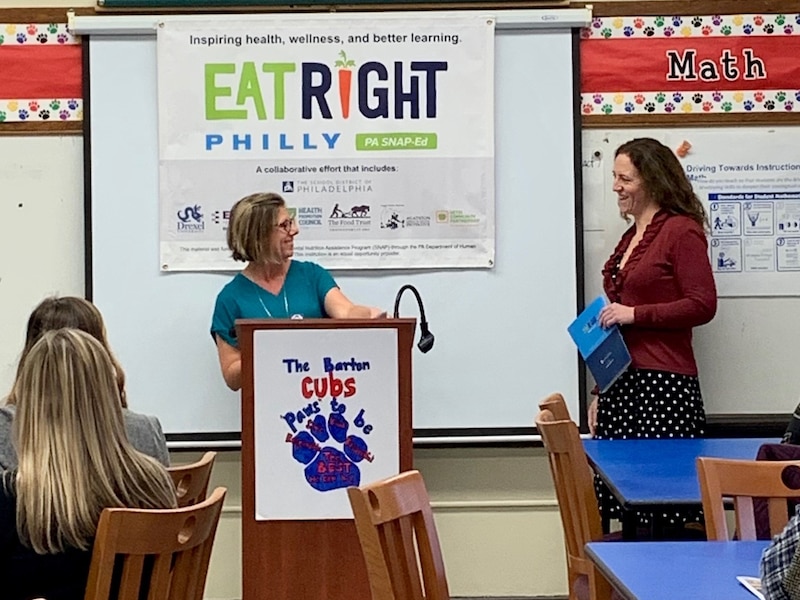This article was originally published in The Notebook. In August 2020, The Notebook became Chalkbeat Philadelphia.
In Philadelphia, whose 25 percent poverty rate is the highest among U.S. big cities, programs such as Eat Right Philly are striving to “support students and families on the pathway to wellness.”
Eat Right Philly released its 2017/18 Outcomes Report on Thursday at a “Wake Up to Wellness Celebration” event at Clara Barton Elementary School to highlight the progress the program has made in the health and wellness of students and families in the District.
The organization also used the event to announce its name change. Previously, the program was called Eat. Right. Now. But the group decided to switch the name to emphasize that health and wellness require long-term commitment.
“We decided to drop the ‘now’ and move to Eat Right Philly because we’re not just looking at the now, we are looking at long-term benefits for our students and families,” said Eat Right Philly director Lauren Nocito in a phone interview. “It is really important for everyone to make long-term healthy choices to work towards increased wellness.”
Eat Right Philly is federally funded through the Supplemental Nutrition Assistance Program Education (SNAP-Ed). According to its website, the program’s mission is “to educate, support, and inspire improved school wellness and culture so School District of Philadelphia students and their families can live a healthy lifestyle and achieve their fullest potential.”
According to the report, six providers – Drexel University, Einstein Healthcare Network, The Food Trust, Vetri Community Partnership, the Agatston Urban Nutrition Initiative and the Health Promotion Council – plus the School District receive SNAP-Ed funding. Each works with selected schools. Their initiatives include community engagement, health education, cooking programs, curriculum development, planting gardens, and running parent workshops, produce stands and food tastings.
Together with the SNAP-Ed providers, Eat Right Philly reaches 197 District schools and 18 charters, which equates to 93,013 students.
Eat Right Philly outlines in its report the specific goals they have for students, schools, and the community. For students, the report says, they want to “help increase knowledge and inspire healthy choices.” For schools, they want to “support schools with resources, training, and technical assistance so the healthy choice is the easy choice,” and for families and the greater community, they want to “support families so children can live their healthiest life.”
The project cites research that concludes: “Food insufficiency is a serious problem affecting children’s ability to learn.”
“We want to continue to move the needle on some of the literacy goals and college and career readiness goals that the District has. We believe, and nobody would deny, that health and wellness play a factor in this,” Nocito said.

Lauren Nocito, the director of Eat Right Philly (left) at the press conference with Mica Root of the Philadelphia Public Health Department’s “Get Healthy Philly” program. (Photo: Danielle Raucheisen)
The event at Barton Elementary featured the school’s produce stand. According to the report, the number of Eat Right Philly produce stands “has grown from one stand in 2014-15 to 25 stands in 2017-18. The stands are conveniently open before and after the school day so caregivers can easily purchase healthy food at cost, allowing them to make the most of limited resources.”
These stands served 5,432 people in 2017-18 with 40,653 pounds of produce purchased. About 13 percent of those transactions utilized EBT/Access cards, which Nocito says inidicates to Eat Right Philly “that [they’re] bringing the fresh, affordable produce to a community that really needs it.”
For 2018-19, Eat Right Philly has four main goals, according to the report:
- More exploration of new healthy food through tasting activities.
- Increased support for full implementation of the District Wellness Policy.
- Even greater collaboration and partnerships with different District offices and external partners for shared outcomes around student nutrition and activity behaviors.
- More support for schools to create the healthiest environment for students.
Through federal funding, organizations such as Eat Right Philly are able to exist, and are “a huge value add to the District,” Nocito said. For many families, fresh produce would never be on the table without Eat Right Philly, and research has shown that the success of students is directly affected by what they are eating.
Said Nocito: “Part of our work is not only about educating about making healthy decisions, but also making that healthy decision easier for families.”


